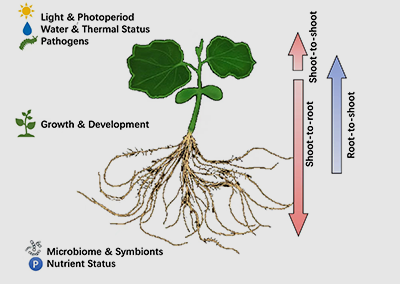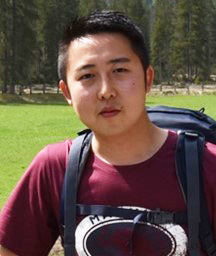Shoot-Root Communication, Grafting Biology and Viral Resistance in Vegetable Crops
 Long-distance communication is essential to coordinate between the different parts of the plant: the shoot, which harnesses solar energy for carbon fixation during photosynthesis, and the root, which absorbs water and mineral nutrients from the soil. Roots and shoots are highly specialized and constantly communicate to coordinate the growth and development of higher plants. These processes are especially important in grafted vegetable crops, and in response to various environmental stimuli. So far, various genetic, biochemical, molecular, and omics studies have identified multiple long-distance trafficking molecules, e.g. hormones, sugars, nutrients, RNAs, proteins and peptides. However, the function of most of these molecules as inter-organ signals regulating the growth, development and stress response of vegetable crops remains largely unknown. This gap of knowledge may become an obstacle in the breeding and production of grafted vegetable crops for the improvement of stress response and produce quality. Elucidating the functions and regulatory mechanisms underlying the long-distance signalling on shoot-root relationships, is therefore significant for achieving efficient improvement of vegetable production.
Long-distance communication is essential to coordinate between the different parts of the plant: the shoot, which harnesses solar energy for carbon fixation during photosynthesis, and the root, which absorbs water and mineral nutrients from the soil. Roots and shoots are highly specialized and constantly communicate to coordinate the growth and development of higher plants. These processes are especially important in grafted vegetable crops, and in response to various environmental stimuli. So far, various genetic, biochemical, molecular, and omics studies have identified multiple long-distance trafficking molecules, e.g. hormones, sugars, nutrients, RNAs, proteins and peptides. However, the function of most of these molecules as inter-organ signals regulating the growth, development and stress response of vegetable crops remains largely unknown. This gap of knowledge may become an obstacle in the breeding and production of grafted vegetable crops for the improvement of stress response and produce quality. Elucidating the functions and regulatory mechanisms underlying the long-distance signalling on shoot-root relationships, is therefore significant for achieving efficient improvement of vegetable production.
To advance the research and our understanding of the shoot-root communication and grafting biology in vegetable crops, we have initiated the following topics for a new special issue. We cordially invite submissions of research articles, short communications, review/mini reviews and perspectives. Please note that the topics we provided may not cover all research in this field. If your topic is related but not listed here, please don’t hesitate to contact us.
Specific topics of interest include:
● The allocation and signaling of sugar/mineral nutrients during shoot-root communication.
● Long-distance and cell-to-cell movement of plant viruses and viral resistance in vegetable crops.
● Hormones, ROS/Ca2+ waves integrate shoot–root development and stress signal response.
● RNAs, proteins or small peptides act as long distance signals in a dynamic balance of scion-stock interaction upon endogenous and exogenous cues.
● Grafting biology and cell biology in of graft compatibility and graft union construction.
● New technologies for studying and/or advancing our understanding of shoot–root communication and grafting biology.
Guest Editors
Dr. Wenna Zhang College of Horticulture, China Agricultural University, 100193 Beijing, China |
Dr. Yihan Dong Centre national de la recherche scientifique, Institut de biologie moléculaire des plantes (CNRS-IBMP), 67000 Strasbourg, France |
Dr. Ziv Spiegelman Department of Plant Pathology and Weed Research, Agricultural Research Organization-Volcani Institute, 7505101 Rishon LeZion, Israel |
Submission Deadline
The deadline for manuscript submissions is 31 Dec 2024, but we can accommodate extensions on a case-by-case basis. All papers will be published as open access articles upon acceptance.
Submission Instructions
Please submit the full manuscript to Vegetable Research via our online submission system. Please choose the topic of this Special Issue when submitting and specify it in your cover letter. For further inquiries, please contact guest editors:
Wenna Zhang (zhangwenna@cau.edu.cn)
Yihan Dong (yihan.dong@ibmp-cnrs.unistra.fr)
Ziv Spiegelman (ziv.spi@volcani.agri.gov.il)

-
{{article.year}}, {{article.volume}}({{article.issue}}): {{article.fpage | processPage:article.lpage:6}}. doi: {{article.doi}}{{article.articleStateNameEn}}, doi: {{article.doi}}Abstract({{article.visitArticleCount}}) Abstract({{article.visitArticleCount}}) HTML HTML PDF({{article.pdfDownloadCount}}){{article.publishDate | date:'dd MMM yyyy' : 'UTC'}}Open Access




